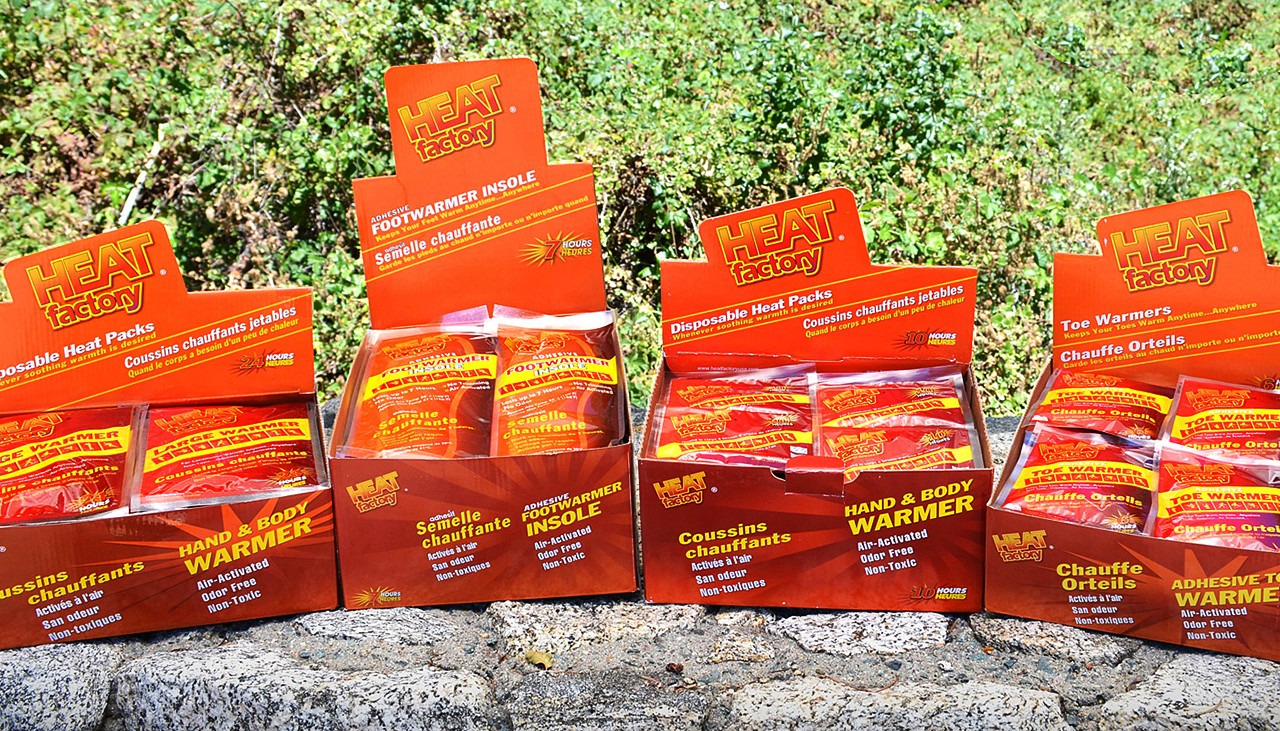Savor our FTC disclosure's epic tale here. The following article was last updated on Oct 25, 2022 ...
Why Charcoal Foot Warmers Beat Electric
In December of 2012, Robin (our own TRO editor-in-chief) was still a newbie-ish rider. He loved riding and wanted to squeeze in as much saddle time as he could. No winter month in Chicago was going to stop this guy! Here's one example video that inspired him.
As long as the roads weren't icy or wet, he would ride his trusty Yamaha Seca 400. His riding gear consisted of basic ATGATT, balaclava and neck warmer + layers (LOTS of layers). No fancy heated gear for this Robin, the Robin of 2012, as his precious monies were earmarked for Seca upgrades.
Robin's main problem while winter riding, besides other riders thinking he was batshit crazy, was keeping his hands and feet warm. What to do?
The internet gave him the answer.
2012 Robin turned to hand and foot warmer inserts. They kept his mitts and tootsies warm, his grin wide as he rode through the winter passing heaps of plowed and shoveled snow. He was happy.
Fast forward four years. Robin has long graduated from his beginner bike and riding gear. It seemed like a good time to give him heated clothing as a gift for his approaching birthday.
It made sense to go with a vest to keep his core warm. It also made sense to get heated gloves because he doesn't have hand guards and his heated grips warm his palms but leave the tops of his fingers cold. His feet were the last priority body part to keep warm.
I almost added heated socks to my shopping cart. Here are a few reasons I didn't pull the trigger:
- Not many options in comparison to the gloves, vests, jacket liners and pant liners. While too many options can be paralyzing, there were three options at the time with price points of $69.95 - small pricey, $99.99 - medium pricey and $194.95 - are you serious right now?
- There's wiring and controllers and plugs and adaptors and cables galore. Motorcycle accessories are strongly represented under the heated clothing category. I could envision the vest and glove wiring but add in socks without pant liners and it seemed like a lot of additional wiring to deal with.
- Another electrical item drawing from the battery, another electrical item that could burn out, shock, overheat and catch on fire.
- Heated socks or insoles are in addition to your riding socks, adding bulk to your boots.
- It's yet another item to prep while getting ready to ride.
I saw two advantages of heated socks: 1) they warm the entire foot (top and bottom) and 2) one-time cost. However, the benefits didn't outweigh what seemed like a big hassle.
2016 Robin loved his heated vest and gloves. Warm feet were tabled for the next year.
Which brings us to now. Another cold season is here and prompting us to reconsider options for warm feet when riding in cool temps.
The face-off between heated socks and foot warmers highlights a clear winner: foot warmers. None of the reasons against heated socks above have changed.
Here's why we like good 'ol simple foot warmers:
- Portable, less bulky unless you're carrying a box of 30 pair around at a time
- Last 5-8 hours, while you may not be riding for 5-8 hours in cold weather, this leads into ...
- Reusable - users report being able to reuse the same warmers five times, which leads into ...
- Cheap - you can buy a single pair for $2.50 (varies depending on whether you opt for toe warmers, foot warmers or insole warmers) or a box of multiple pairs to get you through a few cold rides and more, which leads into ...
- Maybe too obvious but you can use these off the bike, say while shoveling snow, sledding with kids, or doing other snowsports like snowmobiling or skiing
- No wires or batteries needed
- The "technology" is naturally activated materials (click here for the science"y" breakdown), so you're not wearing microwaves or plutonium reactors on your feet
- When you're done, you're done, these are out of your luggage, no repacking and refitting
- Contents are biodegradable, some brands sell biodegradable versions (meaning the pouches the "super-goo" comes in)
- They can be purchased at outdoor and hardware stores in addition to online - you don't need to buy them at a specialty motorcycle retailer and pay for shipping
- A couple of brands are made in the USA: Little Hotties, Grabber and Heat Factory. It's rare to find this anymore. Note: Heat Factory's toe and foot warmers are made in the USA, their insole version is not.
- Easy to use - peel plastic backing, stick to your socks, ride with warm feet in normal riding boots. Next, oh wait, that's it. No wiring diagram needed or accessories needed.
There are things to keep in mind when using foot warmers. There are multiple other articles reviewing the use of these, however for your convenience, here are a few cautions.
- Warmers are air activated, the more exposure to air, the hotter they get. They can heat up to 160 degrees. If they get too hot for you, you can stop the heat by putting them in an air sealed plastic bag. This is also how you can re-use them. More on that below.
- These are meant to be used with enclosed boots and medium or thick socks, don't use with ventilated boots or shoes that allow a fair amount of air to your feet, or the heat will keep on rising and you'll be training for fire walking before you know it.
- Don't use on bare skin, they adhere to your socks.
Are they reusable? Yes. Not something any of the manufacturers advocate but user reviews inspired us to try it ourselves.
We bought Heat Factory's insole foot warmer which lasts "up to 7 hours" with an approximate average temp of 100 degrees. Robin's first use was an hour while wrenching in the garage. He took them off and put them in a plastic bag, squeezing out all the air before sealing. After a few minutes we could feel the heat had stopped.
He put them back in his boots under fresh socks and wore them another hour in the garage. Repeat and rinse. He did this a total of four times.
Was it really seven hours? We love science but we're not that sciencey, so we didn't time each usage. We'll wait until a day we'll need to wear them continuously for 7 hours which is how they're intended to be used. He probably lost some time between the warmers being warmed up and down four times. We're okay with the small amount of time loss considering we can use these over multiple days for shorter blocks of time.
Robin has already bettered his foot warmer reuse method. He sticks the warmers to a thick pair of designated "over" socks. He then puts a thin pair of socks directly onto his feet before slipping into the heated pair, warmers already in place. When he's done, He can pull off the pair with the adhered warmers to save in a sealed plastic bag. The warmers adhesive doesn't get wasted or used up and he's not putting on the same pair of used socks by using this two sock method.
Foot warmers are practical on and off the bike, affordable, easier to use, less bulky and multi-functional. They have a stealth factor, too in that no one will know you've got them on. They'll just see your smiling, happy face while riding because your feet are nice and toasty.

What Cold Weather Solutions Have Kept You Riding?
There are a lot of great freeze-ready riding solutions out there. Which ones have you tried? What did you like about each and why? Your input is invited. Leave a comment!



Comments
I live in the Chicago area I agree. I purchased electric foot warmers that go in sole of boot about a year ago after I purchased a jacket liner and glove liners and I have yet to use them. I have been using these charcoal foot warmers for a couple years. Electric ones are just more to connect and without heated pants it’s a big hassle running wires, etc and even more time to get riding. I can put these in my boots and just go. And as you said you can also use them for outdoor activities in the cold as well without the need for a battery. Probably should never have purchased the powered foot warmers except on sale and I thought I would use them, but I was wrong.
Thanks for your comment, Mark! Maybe you can resell the powered foot warmers.
Two things. First, you can purchase pads the size of a charcoal warmer that are battery operated and plug in to USB for recharge. I haven't priced them, but i imagine just the hassle factor (not managing any landfill material nor storing in airtight bags) would make it preferable by the standards laid out in this article.
Speaking of which, the perception of hassle is of course subjective. The insoles are a semi-permanent addition to the boot, i felt the bulk of a charcoal pad was at least as annoying. To mention my biggest con for these, routing the cords, particularly the part coming out of the boot, is a definite drawback, but something that could be improved a lot with design. These are also points of failure and i am on my 3rd pair in 9 years, but these were $40 so pretty cost effective in the long run. I probably average close to 200 trips in the cold a year, that is a lot of charcoal pads and a lot of futzing with airtight bags. Plugging into a Warm & Safe Heat-troller means the heat can be dialed in precisely and W&S is known for safe, long lasting products. The insoles also provide nice, even heat to the entire boot, compared to the socks (the W&W ones i tried only had a heating section above the toes) and charcoal pads i've tried which emanate heat from more of a limited area (an area that feels like unbalanced bulk in my boot).
I think the charcoal (or battery-powered) pads make sense for someone who makes the occasional winter excursion (or as emergency equipment for normally warm trips). But if you commute in cold weather or plan frequent weekend winter excursions, insoles are worth the slightly greater up front cost. Pairing them with gloves and/or jacket and a W&S controller is best, but if used just by themselves a simple on/off switch is available for cheap.
Agreed and hope that better future design will reduce if not minimize the cord situation. You may be a bit of an outlier compared to the average rider, 200 trips in the cold a year? Then again, maybe not depending on where you live or maybe that number is subjective.
Appreciate your comment, you bring up some interesting alternatives and opinions.
You're halfway to a nice contrasting article. I invite you to submit a post here.